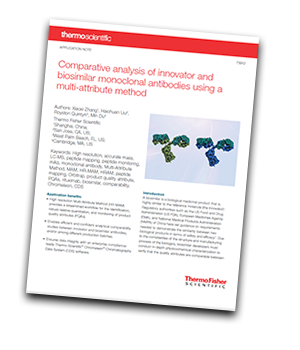This application note demonstrates how a high resolution multi-attribute method (HR-MAM) provides a streamlined workflow for the identification, robust relative quantitation, and monitoring of product quality attributes (PQAs).

 Introduction
Introduction
A biosimilar is a biological medicinal product that is highly similar to the reference molecule (the innovator). Regulatory authorities such as the US Food and Drug Administration (US FDA), European Medicines Agency (EMA), and National Medical Products Administration (NMPA) of China have set guidance on requirements needed to demonstrate the similarity between two biological products in terms of safety and efficacy. Due to the complexities of the structure and manufacturing process of the biologics, biosimilar developers must conduct in-depth physicochemical characterization to verify that the quality attributes are comparable between the biosimilar and the innovator products. To ensure the desired product quality and the molecular similarity with the innovator, identification and monitoring of PQAs are essential for biosimilar development, manufacturing, and quality control.
In this study, we assessed the comparability of biosimilar vs. innovator rituximab under untreated and forced degradation conditions by utilizing the Thermo Scientific™ HR-MAM workflow to efficiently identify, relatively quantify, and monitor the selected PQAs to reduce the analytical testing and increase productivity.
Experimental
Full details of the experimental conditions can be found by downloading the application note.
Results and Discussion
It is important to compare the biosimilarity of the biosimilar drug batches to the innovator product under stressed conditions, including thermal and oxidative stress, to investigate the effects on the PQAs of the biosimilar batches.
Characterization and selection of PQAs by peptide mapping analysis
Peptide mapping is a widely used analytical approach for the comprehensive characterization of biotherapeutics, providing insights into the primary structure information such as sequence confirmation, sequence variants, PTM identification, and localization. In this study, we first utilized a peptide mapping approach to confirm the sequence, identify and select the PQAs.
Conclusion
In this study, we demonstrated how the Thermo Scientific HR-MAM workflow can be used for relative quantitation and monitoring of multiple PQAs simultaneously to improve productivity when assessing the comparability between rituximab innovator vs. biosimilar products and across different batches.




